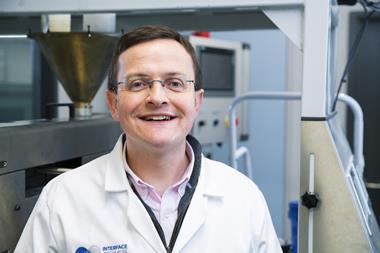A wash in hot water is all it takes to clean up gold nanoparticles and improve their catalytic activity
Upping the catalytic activity of gold nanoparticles can be as simple as a good wash in hot water, UK chemists have shown. The hot water wash strips away ligands stuck to the gold that are left over from nanoparticle synthesis, leaving a clean metal surface with freely accessible active sites.
The technique was discovered by Graham Hutchings at Cardiff University and colleagues, who have been developing surface-supported gold nanoparticle catalysts. One of the most attractive ways to make such systems is to pre-form the gold nanoparticles in a colloidal solution - a technique that allows precise control over particle size and structure - before depositing them onto the support.

While in solution, the nanoparticles must be coated with stabilising polyvinyl alcohol (PVA) ligands to prevent them from clumping together. However, once the nanoparticles have been stuck to a solid support, these ligands can impair the nanoparticle’s performance. For example, they can block light in photosensing applications, or block the approach of chemicals from nanoparticle catalysts and chemosensors.
Previous methods for stripping these ligands away have involved heat treatments of up to 400C, a process that can damage the metal surface by causing sintering - the nanoparticles begin to coalesce, and their catalytic activity drops away. Hutchings has now come up with a much milder alternative. The team showed that treatment with 90C water for an hour removes PVA from surface-supported gold nanoparticles while leaving them intact, maximising their catalytic activity.
’We were trying to think of ways of removing these ligands at much lower temperatures,’ says Hutchings. ’We thought that if you increase the temperature just enough then you might be able to solubilise them - and it turned out that our intuition was right.’
’The idea to just wash the ligands away is brilliant,’ says Thomas Nann, who researches metallic nanoparticles at the Ian Wark Research Institute of the University of South Australia in Adelaide. ’It would be great if this concept could be transferred to other applications where the ligands represent a problem.’ Not all nanoparticles made this way use water-soluble stabilising ligands, and many other metals would be corroded by the hot water.
Hutchings says that, for surface-supported nanoparticles, which water wouldn’t be suitable for, organic solvents could be used instead. ’I would be very surprised if it doesn’t work, but I suspect you’ve got to find specific conditions for any ligand-solvent combination,’ he says.
So far, the work is just a proof of concept that there is a subtler alternative to brute-strength burning off of the stabilising ligands, Hutchings adds. ’We haven’t optimised this at all, we’ve just shown that this is a possibility.’
James Mitchell Crow
Interesting? Spread the word using the ’tools’ menu on the left.
References
J A Lopez-Sanchez et alNat. Chem., 2011, DOI: 10.1038/nchem.1066






No comments yet